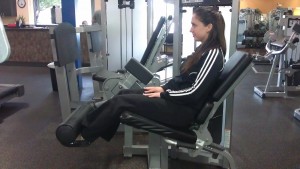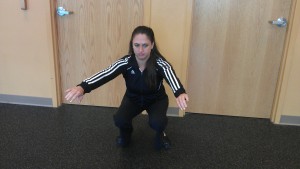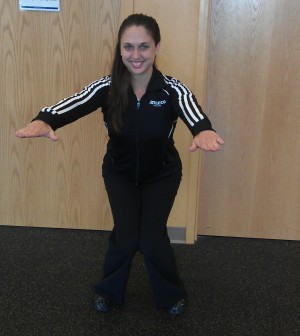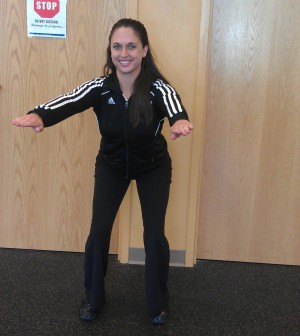
Three Ways to Avoid Knee Pain at the Gym
11 CommentsMany patients come to physical therapy with knee pain as a result of gym workouts. Here are three ways to avoid knee pain while working out at the gym:
1. Consider Avoiding This Machine in the Gym:
Although some people are able to use this machine without pain, others who are prone to having knee pain may increase their pain by using this machine. The combination of the knee motion during use of this machine, with lots of weight at the ankle, may increase the compression force at the knee. This pressure at the knee cap, when it comes in contact with your femur, can be painful and overtime land you in therapy.
2. Watch Your Squatting Mechanics:
Squatting with improper technique places a lot of stress on the knees. Majority of patients who come to me with knee pain are not squatting correctly. Exercising with good technique can prevent knee pain.
Your squat should not look like this: This squat is too deep to perform over and over in the gym and places a lot of stress through the joints.
Your squat also should not look like this: This squat may look silly, but it is often the way people will squat when I ask them to perform a mini squat for the first time, especially if performing a squat on one foot or landing from a jump. If you notice you are squatting like this, first try to correct it. If correcting a squat that looks like this one is too difficult, you may need to strengthen your hips, quads, hamstrings, and/or stretch your calves.
Your squat should look more like this one: Feet flat and toes pointed forward, weight distributed evenly between legs, knee caps pointing forwards between 1st and 2nd toes, sit back so your knees do not bend past your toes.
3. Remember Your Hips!
Knee pain is not just a result of weak knee muscles. Knee pain is often a combination of hip, knee, and ankle involvement. If you have weak hips, the knee pain is likely to follow. Strengthening the hips is often a physical therapist’s greatest tool in helping with knee pain. Here are some exercises to do in the gym to focus on your hip strength:
- Lay on your side with your back against a wall and your legs stacked on top of each other. Keep your toes pointed forwards. Slide your top leg up the wall and then back down without losing contact with the wall. (Using the wall helps keep your body and legs in the right alignment to perform the exercise correctly.)
- Place a theraband around your ankles. Bend your knees slightly and walk sideways for about 15 feet. Facing the same direction, go back the other way. If you do this for a good 2 minutes you should feel tired in the sides of your hips.
Remember to always check with your doctor or physical therapist to ensure these exercises are safe and appropriate for you.
If you are having knee pain, head to your closest Athletico for a complimentary injury screening. The physical therapist or athletic trainer who sees you can help watch your squatting mechanics, test your flexibility and strength, and make recommendations to address your specific pain or discomfort.
Have a topic you would like me to write about? Leave me a comment! Thank you!






11 Comments
Sherril
I had a total hip replacement a year ago and still have a limp,which I am trying to correct.I joined the gym recently to try and strengthen my hip and leg muscles.What would you recommend for me.Ive been cycling and want to train on the circuit as well. I definitely can’t squat.
Sarah Clough
Hi Sherril!
This is a great question that many people have after a hip replacement. Here are some exercise ideas for the gym:
1. Biking is awesome after a hip replacement, so its great you are already doing this!
2. The hip abduction machine. This machine will be the one where you sit with your legs together and have two pads on the outside of your thighs. You push your legs out against the resistance.
3. Hamstring curl machine in sitting. The bar will be behind your ankles and you will pull your ankles back under the chair.
4. Leg press machine in sitting or laying on your back. I would recommend for this one to make sure the plate you are pushing on is stationary, and as you push back your body is what moves, not the plate. Find a good angle so your knees start at 90 degrees and push back to straight knees, and your hips stay at or less than a 90 degree angle.
5. Heel raises: Raise up onto your toes and then back down. You can do this in standing, on a calf machine, or on the leg press machine.
6. Sit in a chair and stand back up. Repeat this to start working on the ability to squat. Progress to holding onto a bar and reaching back to the point that you barely touch the chair and then stand back up.
7. Sit down in a chair and place a theraband around your knees. Pull your knees apart, in and out. Then place the theraband around your ankles, hold onto a wall if needed, and walk sideways.
8. Place a large swiss ball in a chair with arms so it is stable. Lean into the ball with your arms. Bend one knee and move your hip backwards then back to standing and repeat. You can also bend your knee and move your leg out to the side in and out. Repeat on the other leg.
9. Use some theraband or cables to provide some resistance as you perform rows or pull downs with your shoulders. This exercise will make you stabilize through the legs. To make it harder, stand on one foot.
10. If you are able to get down on the ground, find a yoga mat and perform your bridges, clams, and leg raises.
Things to note:
1. Some gyms have an introduction to the equipment session that you can request to become familiar with the machines if you are not already. Start with light weight and work your way up.
2. Remember that every person with a hip replacement is completely different, so if any of the exercises above are too difficult then don’t do them or work your way up to them.
3. Always check with your physician or therapist to ensure these exercises are appropriate for you. Since I am making recommendations via the internet only, each individual is at a different functional level and has different health issues, I cannot say with 100% certainty that the above suggestions are okay for you.
4. If you are in the area and have a close by Athletico, make a screening appointment and sit down with a therapist that can test your strength today, one year out of surgery, to see what might be best for you in the gym. You can take this list with you for reference.
5. Allow around 6 weeks to notice a strength improvement.
I hope this helps! If you have any further questions, or need any of the above clarified, definitely let me know!
Thank you for the question!
manon kavesky
make sure your shoes are not worn down at the heel. Your street shoes as well as your work out shoes. And pick the right shoes for the job, running shoes are not really the best choice for many gym workouts. Running shoes are designed to propel your foot forward to the next stride, not really the motion one needs when performing squats.
Lauri
KEY: Make sure your weight is in your heel and knee in line with ankle!
Most places talk about not letting your knee go past your toe, that is what too far, especially for women.
If you lift up your toes and keep them up your weight will be in your heel and your knee CANNOT go past your ankle. Its all about form.
Jennifer
I am 27 years old, I have been in the military almost 7 years and am very active. I had knee pain on the front of my knee for over 2 years and after physical therapy I had an MRI. The MRI showed that I had a fat pad impingement. I had surgery a little over a month ago and the surgeon removed the entire fat pad. Every since I came off crutches I still felt the same pain I had from before the surgery and the swelling is still very bad.
Sarah Clough
Hi Jennifer!
Please see my response to your post in my other blog on arthritis.
Thank you!
Sarah Clough
Lauri, Manon, and Jai:
Thank you for your posts and great suggestions on squatting mechanics and shoe wear! All great ideas, thoughts, and pointers! Thanks for taking the time to share more on this with the readers!
~Sarah
Barbara Eylers
I am so glad I found your site. My knees were replaced in 1999. I have never had any problem with them. Now I want to exercise with machines to strengthen muscles in legs. I am glad I found your page as I was using the machine (lifting legs with bar under knees. and also doing aqua exercise in water, I have pain in knees now, so will stop using the machine and try to find another one that is gentle on knees. thank you so much.
Sarah Clough
Hi Barbara!
I am so glad the site is helpful! Thanks for reading the blog! ~Sarah
Genevieve Traenkle
Both of my knees have been replaced two years ago. I started working out at the gym with a trainer a few weeks go. I just read the information about the gym equipment where you lift your legs with bars underneath your knees. I used this piece of equipment this past week for the first time and my both knees were in sore all week. I will definitely stay away from that machine! I want to trust my trainer but would really appreciate knowing what specific machines I should not use at the gym? Also, thanks for the “squats” information. It was quite informative.
Sarah Clough
Hi Genevieve!
That is the only machine that I recommend avoiding at the gym as far as leg strengthening machines go. I also tell my patients to avoid repetitive overhead military press and wide grip bench press for shoulder health. All of the other ones should be okay for you!
Thank you for your post!